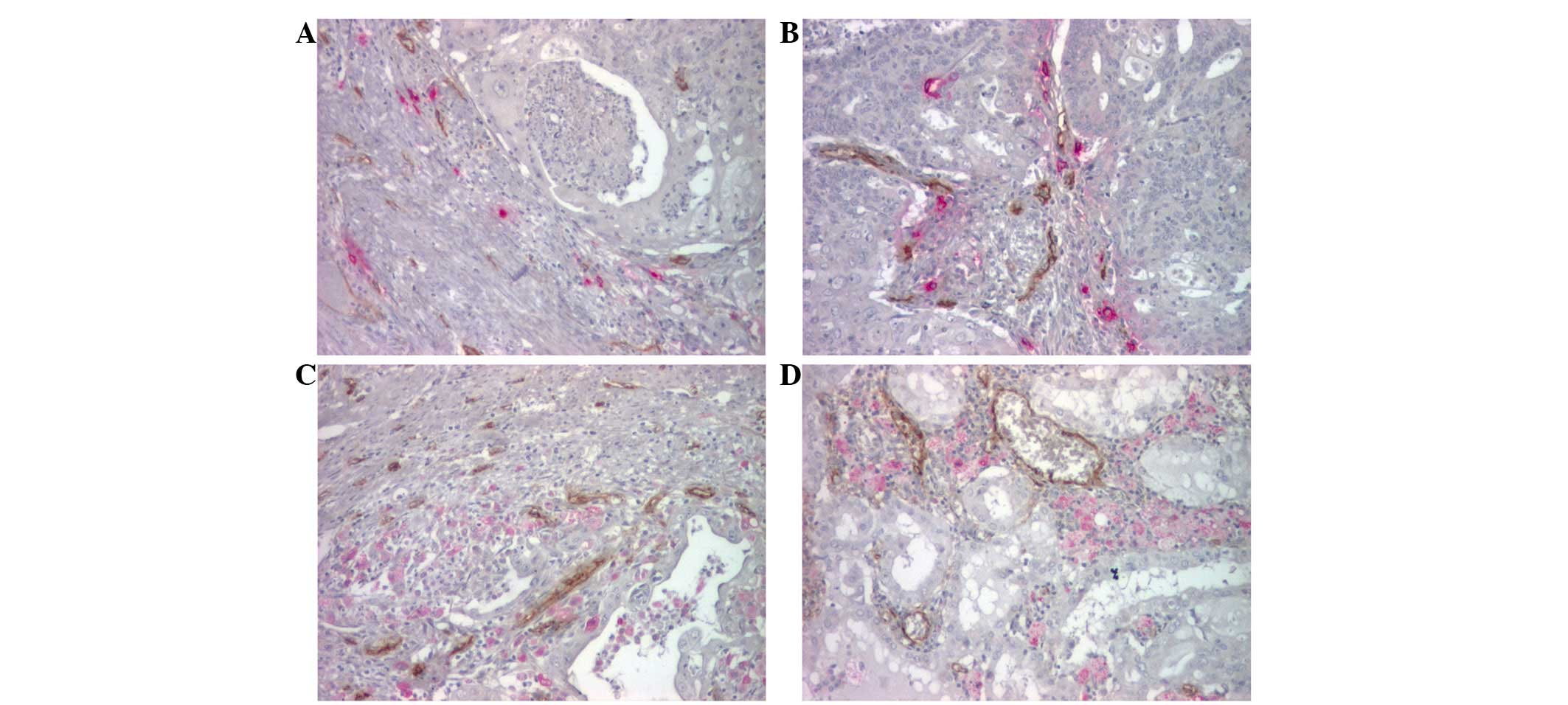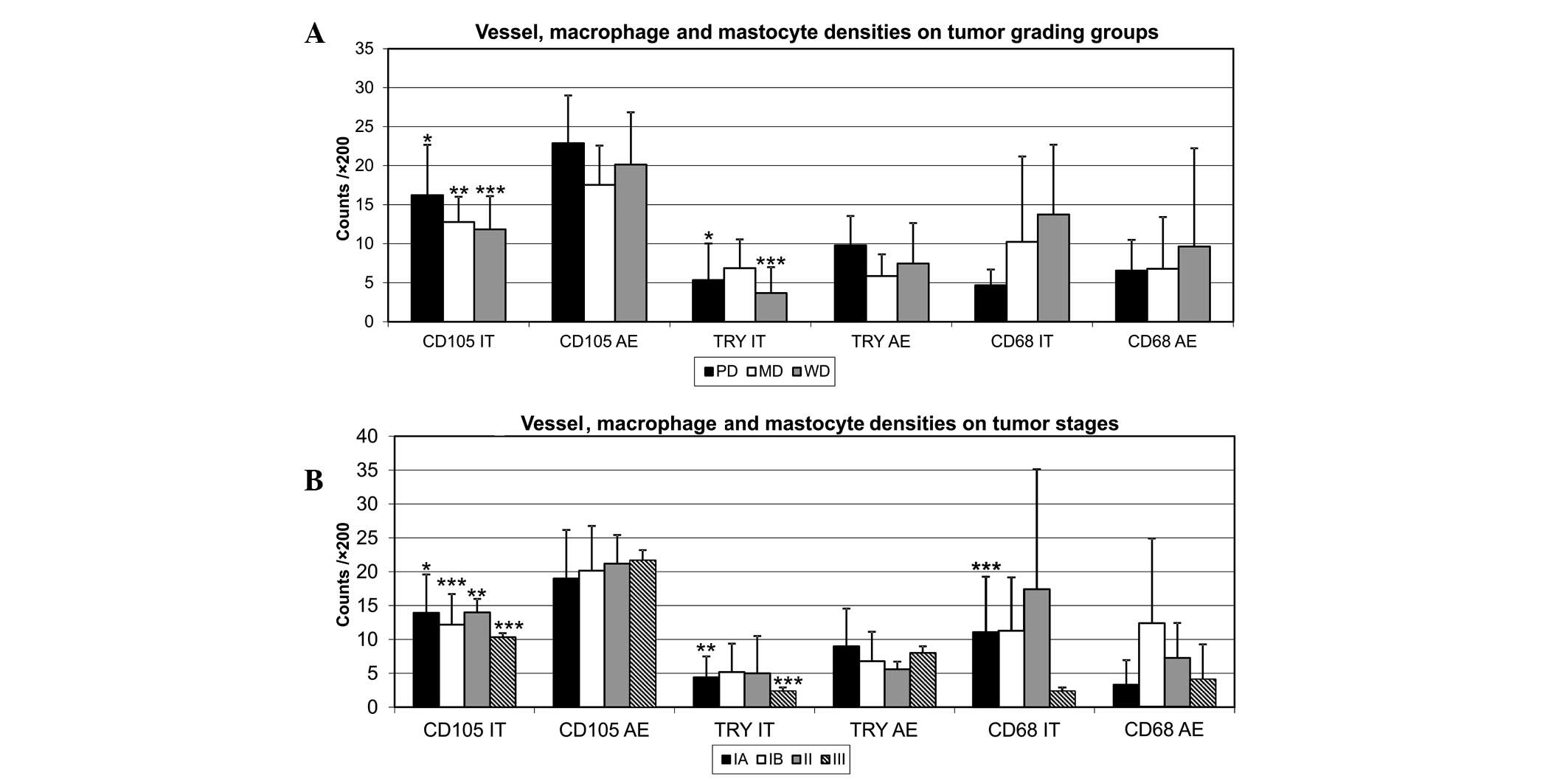|
1.
|
Bokhman JV: Two pathogenetic types of
endometrial carcinoma. Gynecol Oncol. 15:10–17. 1983. View Article : Google Scholar : PubMed/NCBI
|
|
2.
|
Sherman ME: Theories of endometrial
carcinogenesis: a multi-disciplinary approach. Mod Pathol.
13:295–308. 2000. View Article : Google Scholar : PubMed/NCBI
|
|
3.
|
Lax SF: Molecular genetic pathways in
various types of endometrial carcinoma: from a phenotypical to a
molecular-based classification. Virchows Arch. 444:213–223. 2004.
View Article : Google Scholar : PubMed/NCBI
|
|
4.
|
Bansal N, Yendluri V and Wenham RM: The
molecular biology of endometrial cancers and the implications for
pathogenesis, classification, and targeted therapies. Cancer
Control. 16:8–13. 2009.PubMed/NCBI
|
|
5.
|
Theoharides TC and Conti P: Mast cells:
the Jekyll and Hyde of tumor growth. Trends Immunol. 25:235–241.
2004. View Article : Google Scholar : PubMed/NCBI
|
|
6.
|
Crowther M, Brown NJ, Bishop ET and Lewis
CE: Microenvironmental influence on macrophage regulation of
angiogenesis in wounds and malignant tumors. J Leukoc Biol.
70:478–490. 2001.PubMed/NCBI
|
|
7.
|
Kataki A, Scheid P, Piet M, Marie B,
Martinet N, Martinet Y and Vignaud JM: Tumor infiltrating
lymphocytes and macrophages have a potential dual role in lung
cancer by supporting both host-defense and tumor progression. J Lab
Clin Med. 140:320–328. 2002. View Article : Google Scholar : PubMed/NCBI
|
|
8.
|
Lewis CE and Pollard JW: Distinct role of
macrophages in different tumor microenvironments. Cancer Res.
66:605–612. 2006. View Article : Google Scholar : PubMed/NCBI
|
|
9.
|
Murdoch C, Giannoudis A and Lewis CE:
Mechanisms regulating the recruitment of macrophages into hypoxic
areas of tumors and other ischemic tissues. Blood. 104:2224–2234.
2004. View Article : Google Scholar : PubMed/NCBI
|
|
10.
|
Murdoch C, Muthana M and Lewis CE: Hypoxia
regulates macrophage functions in inflammation. J Immunol.
175:6257–6263. 2005. View Article : Google Scholar : PubMed/NCBI
|
|
11.
|
Condeelis J and Pollard JW: Macrophages:
obligate partners for tumor cell migration, invasion, and
metastasis. Cell. 124:263–266. 2006. View Article : Google Scholar : PubMed/NCBI
|
|
12.
|
Dirkx AE, Oude Egbrink MG, Wagstaff J and
Griffioen AW: Monocyte/macrophage infiltration in tumors:
modulators of angiogenesis. J Leukoc Biol. 80:1183–1196. 2006.
View Article : Google Scholar : PubMed/NCBI
|
|
13.
|
Pollard JW: Tumour-educated macrophages
promote tumour progression and metastasis. Nat Rev. 4:71–78. 2004.
View Article : Google Scholar : PubMed/NCBI
|
|
14.
|
Ribatti D and Crivellato E: The
controversial role of mast cells in tumor growth. Int Rev Cell Mol
Biol. 275:89–131. 2009. View Article : Google Scholar : PubMed/NCBI
|
|
15.
|
Blair RJ, Meng H, Marchese MJ, Ren S,
Schwartz LB, Tonnesen MG and Gruber BL: Human mast cells stimulate
vascular tube formation. Tryptase is a novel, potent angiogenic
factor. J Clin Invest. 99:2691–2700. 1997. View Article : Google Scholar
|
|
16.
|
Silverberg SG, Kurman RJ, Nogales F,
Mutter GL, Kubik-Huch RA and Tavassoli FA: Tumors of the uterine
corpus. Epithelial tumors and related lesions. WHO Classification
of Tumors: Pathology and Genetics of Tumors of the Breast and
Female Genital Organs. Tavassoli FA and Devilee P: IARC Press;
Lyon, France: pp. 221–232. 2003
|
|
17.
|
Weidner N, Carroll PR, Flax J, Blumenfeld
W and Folkman J: Tumor angiogenesis correlates with metastasis in
invasive prostate carcinoma. Am J Pathol. 143:401–409.
1993.PubMed/NCBI
|
|
18.
|
Folkman J: What is the evidence that
tumors are angiogenesis dependent? J Natl Cancer Inst. 82:4–6.
1990. View Article : Google Scholar : PubMed/NCBI
|
|
19.
|
Hanahan D and Folkman J: Patterns and
emerging mechanisms of the angiogenic switch during tumorigenesis.
Cell. 86:353–364. 1996. View Article : Google Scholar : PubMed/NCBI
|
|
20.
|
Bergers G and Benjamin LE: Tumorigenesis
and the angiogenic switch. Nat Rev Cancer. 3:401–410. 2003.
View Article : Google Scholar
|
|
21.
|
Ribatti D, Vacca A, Marzullo A, Nico B,
Ria R, Roncali L and Dammacco F: Angiogenesis and mast cell density
with tryptase activity increase simultaneously with pathological
progression in B-cell non-Hodgkin’s lymphomas. Int J Cancer.
85:171–175. 2000.PubMed/NCBI
|
|
22.
|
Hashimoto I, Kodama J, Seki N, Hongo A,
Miyagi Y, Yoshinouchi M and Kudo T: Macrophage infiltration and
angiogenesis in endometrial cancer. Anticancer Res. 20:4853–4856.
2000.PubMed/NCBI
|
|
23.
|
Gargett CE, Lederman F, Heryanto B,
Gambino LS and Rogers PA: Focal vascular endothelial growth factor
correlates with angiogenesis in human endometrium. Role of
intravascular neutrophils. Hum Reprod. 16:1065–1075. 2001.
View Article : Google Scholar : PubMed/NCBI
|
|
24.
|
Ribatti D, Finato N, Crivellato E,
Marzullo A, Mangieri D, Nico B, Vacca A and Beltrami CA:
Neovascularization and mast cells with tryptase activity increase
simultaneously with pathologic progression in human endometrial
cancer. Am J Obstet Gynecol. 193:1961–1965. 2005. View Article : Google Scholar : PubMed/NCBI
|
|
25.
|
Goksu Erol AY, Tokyol C, Ozdemir O,
Yilmazer M, Arioz TD and Aktepe F: The role of mast cells and
angiogenesis in benign and malignant neoplasms of the uterus.
Pathol Res Pract. 207:618–622. 2011.PubMed/NCBI
|
|
26.
|
Cinel L, Aban M, Basturk M, Ertunc D,
Arpaci R, Dilek S and Camdeviren H: The association of mast cell
density with myometrial invasion in endometrial carcinoma: a
preliminary report. Pathol Res Pract. 205:255–258. 2009. View Article : Google Scholar : PubMed/NCBI
|
|
27.
|
Pansrikaew P, Cheewakriangkrai C,
Taweevisit M, Khunamornpong S and Siriaunkgul S: Correlation of
mast cell density, tumor angiogenesis, and clinical outcomes in
patients with endometrioid endometrial cancer. Asian Pac J Cancer
Prev. 11:623–626. 2010.
|
|
28.
|
Espinosa I, José Carnicer M, Catasus L,
Canet B, D’angelo E, Zannoni GF and Prat J: Myometrial invasion and
lymph node metastasis in endometrioid carcinomas: tumor-associated
macrophages, microvessel density, and HIF1A have a crucial role. Am
J Surg Pathol. 34:1708–1714. 2010.
|
|
29.
|
Soeda S, Nakamura N, Ozeki T, Nishiyama H,
Hojo H, Yamada H, Abe M and Sato A: Tumor-associated macrophages
correlate with vascular space invasion and myometrial invasion in
endometrial carcinoma. Gynecol Oncol. 109:122–128. 2008. View Article : Google Scholar
|
|
30.
|
Salvesen HB and Akslen LA: Significance of
tumour-associated macrophages, vascular endothelial growth factor
and thrombospondin-1 expression for tumour angiogenesis and
prognosis in endometrial carcinomas. Int J Cancer. 84:538–543.
1999. View Article : Google Scholar
|
|
31.
|
Ohno S, Ohno Y, Suzuki N, Kamei T, Koike
K, Inagawa H, Kohchi C, Soma G and Inoue M: Correlation of
histological localization of tumor-associated macrophages with
clinico-pathological features in endometrial cancer. Anticancer
Res. 24:3335–3342. 2004.PubMed/NCBI
|
|
32.
|
Erol AY and Ozdemir O: Do mast cell
phenotypes play a role in concomitantly increased microvessel
density and progression of non-small cell lung cancer? Hum Pathol.
42:1056–1057. 2011. View Article : Google Scholar : PubMed/NCBI
|
|
33.
|
Saad RS, Jasnosz KM, Tung MY and Silverman
JF: Endoglin (CD105) expression in endometrial carcinoma. Int J
Gynecol Pathol. 22:248–253. 2003. View Article : Google Scholar : PubMed/NCBI
|
|
34.
|
Salvesen HB, Gulluoglu MG, Stefansson I
and Akslen LA: Significance of CD 105 expression for tumour
angiogenesis and prognosis in endometrial carcinomas. APMIS.
111:1011–1018. 2003. View Article : Google Scholar : PubMed/NCBI
|
|
35.
|
Ribatti D, Nico B, Finato N and Crivellato
E: Tryptase-positive mast cells and CD8-positive T cells in human
endometrial cancer. Pathol Int. 61:442–444. 2011. View Article : Google Scholar : PubMed/NCBI
|











